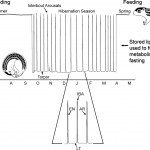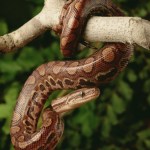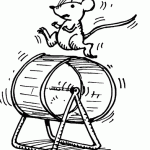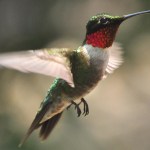muscle
Image of a gilthead sea bream by Roberto Pillon - via Wikimedia Commons
Similar to humans, muscle growth in fish is increased with exercise. Unlike humans, however, teleost fish are able to continue growing in length as well as weight throughout their lives. This type of meat, I mean muscle, growth happens in two ways: 1) muscle cells get bigger and 2) new muscle cells form. Researchers at the University of Barcelona in Spain wanted to know what effect moderate sustained swimming would have on the muscles of young fingerling gilthead sea bream, a type of…
Skeletal muscle function and structure change as we age. Humans typically experience a loss of muscle mass or muscle weakness which can greatly reduce mobility and stability. While much is known about aging skeletal muscle in humans and rodents, less is known about horses, which are rather athletic animals that are living longer due to advancements in veterinary care and retirement programs. Researchers from the University of Florida decided to explore how aging effects skeletal muscles of horses. To do this, they examined gluteus medius (speed and locomotion)…
Photo by: Myrabella / Wikimedia Commons, via Wikimedia Commons
With the approach of summer, a timely study was published in the American Journal of Physiology - Regulatory, Integrative and Comparative Physiology on whether inflammation plays a role in heat stress-related complications in muscles. Heat stress is a major problem in the livestock industry. In the United States alone it is reportedly associated with a loss of approximately $158 billion annually in the swine industry. To cool off, swine seek shade and often mud baths (which mimic sweating by …
Dr. Stan Lindstedt, Northern Arizona University Recipient of the 2013 August Krogh lectureship, American Physiological Society, Comparative and Evolutionary Physiology section
I am thrilled to see Dr. Stan Lindstedt's review article published in the April 2015 issue of American Journal of Physiology: Regulatory, Integrative and Comparative Physiology from his 2013 August Krogh lectureship at the annual Experimental Biology conference. My original blog from the lecture can be found here.
Dr. Lindstedt and co-author Dr. Niisa Nishikawa (Northern Arizona University), describe the…
Image from the American Physiological Society's website.http://www.the-aps.org/mm/Conferences/APS-Conferences/2014-Conferences/…
Wednesday was the last day of the meeting that culminated in a closing banquet with an awards session to honor students who had exceptional presentations. What an impressive group of young comparative physiologists! The plenary lecture was given by Dr. Steven Chown (Monash Univ, Australia). He spoke about climate change forecasts and continuing environmental changes and how important it is to understand how animals adapt to changing conditions in order to…
Image of a green tree python from www.kids.britannica.com J.H. Pete Carmichael—The Image Bank/Getty Images
Dr. Greg Byrnes (Siena College, Loudonville, NY) and Dr. Bruce Jayne (University of Cincinnati, OH) discovered that snakes use more force than is necessary to support their weight when climbing. To climb, snakes rely on friction and repeatedly contract and extend their bodies, a process called concertina locomotion. To study the forces generated by snakes during this type of locomotion, the researchers constructed a vertical cylinder that was covered with textured tennis racket…
Cartoon image from www.teenwritersblog.com
Physiologist Laurie Goodyear (Joslin Diabetes Center, Harvard Medical School, MA) and her colleagues recently published a study in the American Journal of Physiology that shows how overexpressing a protein can increase exercise capacity. The protein of interest was tribbles homolog 3 (TRB3), which is a mammalian form of the tribbles protein found in fruit flies (aka: Drosophila). Prior to this study, data suggested that TRB3 plays a role in metabolism so Dr. Goodyear's team decided to examine this more closely in skeletal muscle, which is a major…
Brandy Velten (doctoral student) and Dr. Kenneth Welch (Comparative Physiologist) from the University of Toronto wanted to know whether birds with very different speeds at which they flaps their wings (i.e. wingbeat frequencies) had correspondingly varying types of myosin proteins in their muscles. Their findings were published in the American Journal of Physiology last month.
In their study they compared ruby-throated hummingbirds and zebra finches which reportedly have some of the highest wingbeat frequencies (20-60Hz). As you can imagine, their flight muscles are made up of almost…
I am very excited to report that the Puerto Rico Physiological Society will be hosting their 4th annual meeting, "Exercise Physiology: From Molecules to Systems" on February 8th.
PRPS 2014 Save the Date
Last year's meeting was focused on mitochondria and was a big success. This year's meeting is shaping up to be similarly successful.
by Katie the Lowly Intern
You might recall this gentle soul who got her face gnawed off by a chimp in February. I won't even begin to sift through the big ball of bizarre that story is, but it does lead to an interesting discussion concerning exactly where apes get enough strength to go around mauling humans. Biologists agree that a great ape's muscle structure is better, faster, stronger than our measly muscles. However, Alan Walker, a professor of Biology at Penn State just published an article in Current Anthropology that looks at another possible contributing factor.
He makes the…




